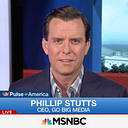The Moonshot Chapter 10 — Update On My Clinical Trial
Two years ago, I took a life-changing moonshot.
Diagnosed in 2012 with Achalasia, a rare, incurable esophageal disease, I vowed to find a cure within five years.
What’s Achalasia?
The basic explanation is that my esophageal muscles and nerves are dead and will never work again. From the food I eat to the way I eat it, I have to think hard before I take each bite. Eating is a chore. Physically and mentally, it is a process I deal with every single day.
After 15 minor procedures and three major surgeries, it’s best to describe my appendage as looking like an upside-down cheerleader’s pompom. The doctors have shredded it.
The other side of the equation is how I dealt with the disease for the first few years after my diagnosis. Franky, I didn’t handle it very well.
I stuck my head in the sand. In fact, I was so paralyzed by fear that I didn’t even google “Achalasia” until 2016 when my doctor at the Mayo Clinic warned me that my medications might have long-term dementia effects and I would be consuming food from a feeding tube soon.
And that’s when I woke up.
Inspired by Peter Diamandis’ “moonshot challenge,” I began working to find a cure in short order.
If you think about it, this is an absurd challenge. There is little money invested in curing rare diseases (Achalasia affects 1 out of 100,000 people and the typical age range is 60+. I was 37 when diagnosed).
When I told my doctor at the Mayo Clinic about my moonshot to find a cure, he smiled and told me, “Phillip, your disease ‘is what it is.’ Take your medications and see you in six months.”
I didn’t listen to him.
Those that have followed my story, know I assembled a team of doctors and started working towards the first-ever, one-man clinical trial to find a cure.
After years of meetings, clinical submissions, and delays, we finally received the green light a few weeks ago to start — and everything with my clinical trial has now changed.
So, here’s what happened:
Last Tuesday, I traveled to The Johns Hopkins University Hospital in Baltimore, where a surgeon biopsied skeletal muscle stem cells from my thigh.
The procedure was unique, to say the least — it’s as if someone took a wine corkscrew, twisted it into my thigh, collected the necessary muscle/stem cells and then unscrewed it. Ugh.
The skeletal muscle stem cells they extracted were then cryopreserved, and are currently sitting in a specialized clinic (known as the Cook MyoSite) where they will be cultivated over the next 3–5 months.
There is a chance this step will fail — that the stem cells won’t grow. But if all goes well, we will soon move to step 2, where the plan is to return to Johns Hopkins and my doctor will insert 50% of the cultured stem cells into my esophagus with the hopes that the nerves and muscles regenerate and begin working again.
That’s the hope. And since it’s never been done before (not even on animals), we are flying blind.
I’m ready.
This whole clinical trial process reminds me of a roller coaster ride where you take the long uphill climb in a boxcar, only to peak, pause, and then you finally tip down…and away you go (with butterflies in your stomach too)!
So, step 1 is halfway home — that roller coaster is edging downhill — and I am eternally grateful to the amazing doctors and team members at Johns Hopkins and Cook MyoSite who are taking this ride with me.
My takeaways for you:
- My advice to you with whatever is going on in your life — don’t wait for the pain to be so severe that you move from inaction to action. For years, I let this disease disrupt me. I did nothing about it, not even googling it. I was such an idiot. Only when the pain was so severe, did I say “enough-is-enough.” I decided it was time to stop being disrupted, and be the disruptor. That mindset changed my life — not only did it inspire me to take this moonshot, it positively changed my relationships and my businesses. Society and social media will tell you to be a victim. Don’t do that. Be the disruptor.
- It’s not just about my moonshot for a cure, it’s also about my diet. I’m beyond grateful to Dr. Steven Gundry, who tackled the diet side of my disease — I completely transformed my diet and it allowed me to remove all prescription medication from my life. Yes, I have an incurable disease, and yet, I don’t take any medication because my diet is in-line with what my body needs. Dr. Gundry is responsible for this, so consider his anti-lectin philosophy — here’s more about it: The Longevity Paradox: How to Die Young at a Ripe Old Age, The Plant Paradox: The Hidden Dangers in”Healthy” Foods That Cause Disease and Weight Gain, and The Plant Paradox Quick and Easy: The 30-Day Plan to Lose Weight, Feel Great, and Live Lectin-Free.
P.S. — If you know of a friend or a colleague that would enjoy my bi-weekly updates about incredibly cool, funny and idiotic marketing ideas, please have them email me (ps@phillipstutts.com) or sign up at PhillipStutts.com.
